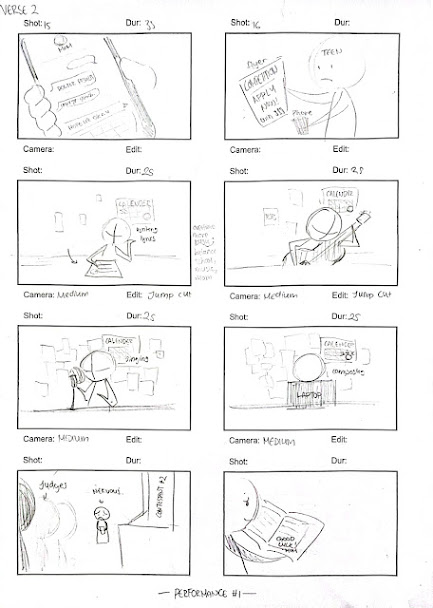A storyboard, defined by Teachfloor, is said to be "a visual representation of a story, often in the form of illustrations or images, arranged in a specific order to show the sequence of events in a film, video, etc."
I had taken the time to learn a little more on storyboards and what is expected through this blog by the BBC - https://www.bbc.co.uk/bitesize/guides/z2vrhv4/revision/2 - however my teacher had ended up providing us templates to aid in our storyboard process. It included 2 templates, one wth 4 large boxes for detailed and another with 8 smaller boxes. Our teacher had suggested us to draw out the scenes from a singular location rather than planning the cuts between a performance to a b-roll, with the intention of reducing confusion in the narrative. Because of this, most shots did not have a defined duration, as it can vary depending on where it will be placed in the editing phase.
By the second detailed page, we were asked to show our progress to our teacher and he was able to give us suggestions on our storyboard and narrative. He informed us on his concern over how well we would be able to communicate the different flashbacks/timestamps that were happening since we did not have access to actors of different ages, which prompted him to suggest a different approach of one flashback and a continous display of the artist's journey through her career from the mother's camera perspective. We, as a group, all agreed to this new narrative as it felt as though our message could be delivered more clearly and readjusted our previous planning to fit towards it.
In these first few pages, I had used 2 pages of big boxes to draw out my ideas in detail, however, I will be switching to the pages with smaller boxes moving on to be more time-efficient. Since I would focus less on detail, I will be able to spend more time in ensuring the ideas all throughout the video will be comprehensible (due to the limited space to write descriptions) to both my team members and my teacher. This is the continuation of the storyboard.
In these first few pages, I had used 2 pages of big boxes to draw out my ideas in detail, however, I will be switching to the pages with smaller boxes moving on to be more time-efficient. Since I would focus less on detail, I will be able to spend more time in ensuring the ideas all throughout the video will be comprehensible (due to the limited space to write descriptions) to both my team members and my teacher. This is the continuation of the storyboard.
There are still some scenes missing, which include the scene from the bridge as my team and I had not been able to have the time to properly discuss our next plan of action and realign our vision. Thus there will be more to come. However, for the sake of the due date, this will be all to submit at the current moment.
Reflection: I didn't really contribute into the making of the storyboard other than giving a few ideas whenever Regine feels stuck on what to do for certain scenes. Though as stated above, we experienced a difficulty in making the flashback and flashforward cuts clear in which this led us to have to modify a bit of the storyline when we thought that our narrative is already fixed. However, it is relieving to receive feedback by my teacher early on in the project as there are always room for us to improve our work before we officially submit it to Cambridge.





No comments:
Post a Comment